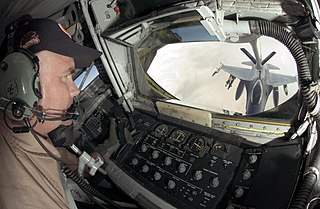 W
WIn the U.S. Air Force (USAF), a boom operator is an aircrew member aboard tanker aircraft who is responsible for safely and effectively transferring aviation fuel from one military aircraft to another during flight. The name boom operator implies that one "operates a boom", which is a long, extendable metal arm attached to the rear underside of the tanker that the boom operator connects to the fuel receptacle of a receiving aircraft. The boom operator also controls the refueling drogue, a basket attached to a flexible hose that trails the tanker, when using the probe-and-drogue system. The USAF officially designates the boom operator career field as "In-Flight Refueling" with a specialty code of 1A0X1. However, this designation is usually reserved for administrative paperwork such as enlistment contracts and performance reports, as boom operators themselves are rarely referred to as in-flight refueling specialists within the USAF. The title "Boom Operator" is most commonly used, in reference to the aircrew position they occupy on the airplane, as noted in USAF regulations and aircraft flight manuals. Fellow crew members affectionately address them as "boom" or "boomer".
 W
WA drill instructor is a non-commissioned officer in the armed forces or police forces with specific duties that vary by country. Foot drill, military step, and marching are typically taught by drill instructors.
 W
WHiwi, the German abbreviation of the word Hilfswilliger or, in English, auxiliary volunteer, designated, during World War II, the member of different kinds of voluntary auxiliary forces made up of recruits indigenous to the territories of Eastern Europe occupied by Nazi Germany. Adolf Hitler reluctantly agreed to allow recruitment of Soviet citizens in the Rear Areas during Operation Barbarossa. In a short period of time, many of them were moved to combat units.
 W
WInformation systems technician (IT) is a rating for United States Navy and United States Coast Guard enlisted personnel, specializing in communications technology. Information systems technician submarines (ITS) is a rating for U.S. Navy submariners. The Information systems technician (IT) rating corresponds to the new Navy Occupational Specialty (NOS) code B460 while the information systems technician submarines (ITS) rating corresponds to Navy Occupational Specialty (NOS) code C260.
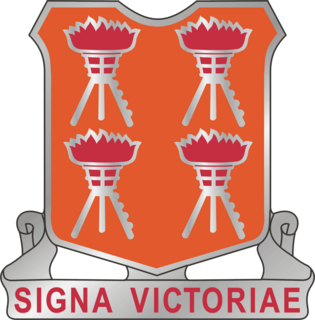 W
WInformation Technology Specialist or Information Systems Operator-Analyst is a Military Occupational Specialty (MOS) in the United States Army. Information Technology Specialists have the responsibility of maintaining, processing and troubleshooting military computer systems and operations.
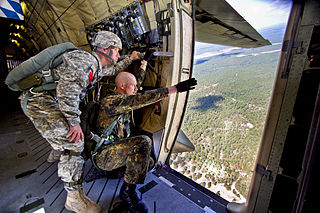 W
WJumpmasters are the expert paratroopers in an airborne unit who train and teach the military techniques for jumping from airplanes. They are responsible for training soldiers who enter Army Airborne School into paratroopers and managing airborne jump operations in airborne units across all branches of services.
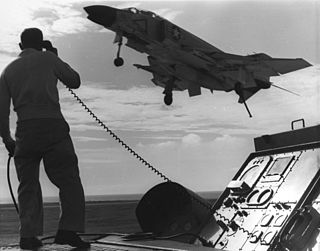 W
WA landing signal officer or landing safety officer (LSO), also informally known as paddles or batsman, is a naval aviator specially trained to facilitate the "safe and expeditious recovery" of naval aircraft aboard aircraft carriers. Originally LSOs were responsible for bringing aircraft aboard ship using hand-operated signals. Since the introduction of optical landing systems in the 1950s, LSOs assist pilots by giving information via radio handsets.
 W
WA military band is a group of personnel that performs musical duties for military functions, usually for the armed forces. A typical military band consists mostly of wind and percussion instruments. The conductor of a band commonly bears the title of Bandmaster or Director of Music. Ottoman military bands are thought to be the oldest variety of military marching bands in the world, dating from the 13th century.
 W
WA military chaplain ministers to military personnel and, in most cases, their families and civilians working for the military. In some cases they will also work with local civilians within a military area of operations.
 W
WMilitary education and training is a process which intends to establish and improve the capabilities of military personnel in their respective roles. Military training may be voluntary or compulsory duty. It begins with recruit training, proceeds to education and training specific to military roles, and sometimes includes additional training during a military career. Directing staff are the military personnel who comprise the instructional staff at a military training institution.
 W
WThe term military medicine has a number of potential connotations. It may mean:A medical specialty, specifically a branch of occupational medicine attending to the medical risks and needs of soldiers, sailors and other service members. This disparate arena has historically involved the prevention and treatment of infectious diseases, and, in the 20th Century, the ergonomics and health effects of operating military-specific machines and equipment such as submarines, tanks, helicopters and airplanes. Undersea and aviation medicine can be understood as subspecialties of military medicine, or in any case originated as such. Few countries certify or recognize "military medicine" as a formal speciality or subspeciality in its own right. The planning and practice of the surgical management of mass battlefield casualties and the logistical and administrative considerations of establishing and operating combat support hospitals. This involves military medical hierarchies, especially the organization of structured medical command and administrative systems that interact with and support deployed combat units. The administration and practice of health care for military service members and their dependents in non-deployed (peacetime) settings. This may consist of a medical system paralleling all the medical specialties and sub-specialties that exist in the civilian sector. Medical research and development specifically bearing upon problems of military medical interest. Historically, this encompasses all of the medical advances emerging from medical research efforts directed at addressing the problems encountered by deployed military forces many of which ultimately prove important beyond the purely military considerations that inspired them.
 W
WNursing is a profession within the health care sector focused on the care of individuals, families, and communities so they may attain, maintain, or recover optimal health and quality of life. Nurses may be differentiated from other health care providers by their approach to patient care, training, and scope of practice. Nurses practice in many specialties with differing levels of prescription authority. Many nurses provide care within the ordering scope of physicians, and this traditional role has shaped the public image of nurses as care providers. However, nurse practitioners are permitted by most jurisdictions to practice independently in a variety of settings. Since the postwar period, nurse education has undergone a process of diversification towards advanced and specialized credentials, and many of the traditional regulations and provider roles are changing.
 W
WThe Royal Navy Chaplaincy Service provides chaplains to the Royal Navy. The chaplains are commissioned by the Sovereign but do not hold military rank other than that of "Chaplain Royal Navy". They are usually addressed as Padre, Reverend or more informally Bish. Chaplains are recruited from a number of Christian denominations.
 W
WA sutler or victualer is a civilian merchant who sells provisions to an army in the field, in camp, or in quarters. Sutlers sold wares from the back of a wagon or a temporary tent, traveling with an army or to remote military outposts. Sutler wagons were associated with the military, while chuck wagons served a similar purpose for civilian wagon trains and outposts.
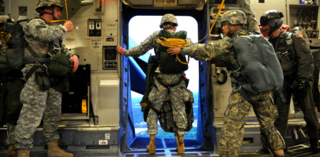 W
WThe United States Army Jumpmaster School trains personnel in the skills necessary to jumpmaster a combat-equipped jump and the proper attaching, jumping, and releasing of combat and individual equipment while participating in an actual jump that is proficient in the duties and responsibilities of the Jumpmaster and Safety; procedures for rigging individual equipment containers and door bundles; personnel parachute components by their specific nomenclature and characteristics; procedures and standards required to conduct a JumpMaster Personnel Inspection (JMPI); the duties and responsibilities of the Drop Zone Safety Officer; the presentation of the Jumpmaster briefing and sustained airborne training (SAT); and the execution of the duties of a Jumpmaster and Safety from a USAF aircraft during a day/night combat equipment jump.
 W
WThe mission of the United States Army Pathfinder School is to train personnel in the U.S. Army and its sister services in a three-week course, during which the candidate pathfinder learns how to navigate dismounted, establish and operate a day / night helicopter landing zone, establish and operate day / night parachute drop zones (DZs), including computed air release system (CARP) DZs, ground marked release system (GMRS) DZs and Army verbally initiated release system (VIRS) DZs, conduct sling load operations, provide air traffic control (ATC) and navigational assistance to rotary wing (RW) and fixed wing (FW) airborne operations. All training and airborne operations will be conducted in accordance with FM 3-21.220 and FM 3-21.38.
 W
WVivandière or cantinière is a French name for women attached to military regiments as sutlers or canteen keepers. Their actual historic function of selling wine to the troops and working in canteens led to the adoption of the name 'cantinière' which came to supplant the original 'vivandière' starting in 1793, but the use of both terms was common in French until the mid-19th century, and 'vivandière' remained the term of choice in non-French-speaking countries such as the US, Spain, Italy, and Great Britain. Vivandières served in the French army up until the beginning of World War I, but the custom spread to many other armies. Vivandières also served on both sides in the American Civil War, and in the armies of Spain, Italy, the German states, Switzerland, and various armies in South America, though little is known about the details in most of those cases as historians have not done extensive research on them.